Performance of Land Use and Land Cover Classification Models in Assessing Agricultural Behavior in the Alagoas Semi-Arid Region
Abstract
1. Introduction
2. Materials and Methods
2.1. Study Area Characterization
2.2. Methodological Flowchart
2.3. Obtaining the Shapefile of the Canal
2.4. Land Use and Land Cover (LULC) Classification Methodologies
2.4.1. LULC by MapBiomas
2.4.2. LULC by Random Forest
2.5. Accuracy Assessment of Random Forest and MapBiomas
2.6. Generation of the Normalized Difference Vegetation Index (NDVI)
2.7. Analysis of Water Abstraction Points and Water Grants in the Canal Areas
2.8. Field Visits for Agriculture Validation
2.9. Temporal Analysis of Land Use and Land Cover Classes
2.10. Seasonal Variation in Precipitation
3. Results
3.1. Validation of Land Use and Land Cover Classification Models
3.2. On-Site Validation of the Accuracy of the Random Forest and MapBiomas Models for Agriculture Classification
3.3. Validation and Correlation Between Estimated Data (Random Forest) and Irrigation Census Registration Data (SEMARH)
3.4. Normalized Difference Vegetation Index (NDVI)
3.5. Land Use and Land Cover (LULC) Analysis (MapBiomas)
3.6. Temporal and Spatial Analysis of Irrigated Areas (Random Forest)
3.7. Seasonal Precipitation Variations: Comparison Between Wet and Dry Periods
4. Discussion
4.1. MapBiomas
4.2. Random Forest
5. Conclusions
Author Contributions
Funding
Data Availability Statement
Acknowledgments
Conflicts of Interest
References
- De Souza Medeiros, A.; Gonzaga, G.B.M.; da Silva, T.S.; de Souza Barreto, B.; dos Santos, T.C.; de Melo, P.L.A.; de Araújo Gomes, T.C.; Maia, S.M.F. Changes in Soil Organic Carbon and Soil Aggregation Due to Deforestation for Smallholder Management in the Brazilian Semi-Arid Region. Geoderma Reg. 2023, 33, e00647. [Google Scholar] [CrossRef]
- Carvalho, A.L.; Araújo-Neto, R.A.; Lyra, G.B.; Cerri, C.E.P.; Maia, S.M.F. Impact of Rainfed and Irrigated Agriculture Systems on Soil Carbon Stock under Different Climate Scenarios in the Semi-Arid Region of Brazil. J. Arid. Land 2022, 14, 359–373. [Google Scholar] [CrossRef]
- Halder, S.; Das, S.; Basu, S. Use of Support Vector Machine and Cellular Automata Methods to Evaluate Impact of Irrigation Project on LULC. Environ. Monit. Assess. 2023, 195, 3. [Google Scholar] [CrossRef]
- Knauer, K.; Gessner, U.; Fensholt, R.; Forkuor, G.; Kuenzer, C. Monitoring Agricultural Expansion in Burkina Faso over 14 Years with 30 m Resolution Time Series: The Role of Population Growth and Implications for the Environment. Remote Sens. 2017, 9, 132. [Google Scholar] [CrossRef]
- Traoré, F.; Bonkoungou, J.; Compaoré, J.; Kouadio, L.; Wellens, J.; Hallot, E.; Tychon, B. Using Multi-Temporal Landsat Images and Support Vector Machine to Assess the Changes in Agricultural Irrigated Areas in the Mogtedo Region, Burkina Faso. Remote Sens. 2019, 11, 1442. [Google Scholar] [CrossRef]
- Dangui, K.; Jia, S. Water Infrastructure Performance in Sub-Saharan Africa: An Investigation of the Drivers and Impact on Economic Growth. Water 2022, 14, 3522. [Google Scholar] [CrossRef]
- Zhao, Y.; An, R.; Xiong, N.; Ou, D.; Jiang, C. Spatio-Temporal Land-Use/Land-Cover Change Dynamics in Coastal Plains in Hangzhou Bay Area, China from 2009 to 2020 Using Google Earth Engine. Land 2021, 10, 1149. [Google Scholar] [CrossRef]
- Magidi, J.; Nhamo, L.; Mpandeli, S.; Mabhaudhi, T. Application of the Random Forest Classifier to Map Irrigated Areas Using Google Earth Engine. Remote Sens. 2021, 13, 876. [Google Scholar] [CrossRef]
- Ragettli, S.; Herberz, T.; Siegfried, T. An Unsupervised Classification Algorithm for Multi-Temporal Irrigated Area Mapping in Central Asia. Remote Sens. 2018, 10, 1823. [Google Scholar] [CrossRef]
- Gumma, M.K.; Thenkabail, P.S.; Teluguntla, P.G.; Oliphant, A.; Xiong, J.; Giri, C.; Pyla, V.; Dixit, S.; Whitbread, A.M. Agricultural Cropland Extent and Areas of South Asia Derived Using Landsat Satellite 30-m Time-Series Big-Data Using Random Forest Machine Learning Algorithms on the Google Earth Engine Cloud. GIsci. Remote Sens. 2020, 57, 302–322. [Google Scholar] [CrossRef]
- Deines, J.M.; Kendall, A.D.; Crowley, M.A.; Rapp, J.; Cardille, J.A.; Hyndman, D.W. Mapping Three Decades of Annual Irrigation across the US High Plains Aquifer Using Landsat and Google Earth Engine. Remote Sens. Environ. 2019, 233, 111400. [Google Scholar] [CrossRef]
- Phalke, A.R.; Özdoğan, M.; Thenkabail, P.S.; Erickson, T.; Gorelick, N.; Yadav, K.; Congalton, R.G. Mapping Croplands of Europe, Middle East, Russia, and Central Asia Using Landsat, Random Forest, and Google Earth Engine. ISPRS J. Photogramm. Remote Sens. 2020, 167, 104–122. [Google Scholar] [CrossRef]
- Neves, A.K.; Körting, T.S.; Fonseca, L.M.G.; Escada, M.I.S. Assessment of TerraClass and MapBiomas Data on Legend and Map Agreement for the Brazilian Amazon Biome. Acta Amaz. 2020, 50, 170–182. [Google Scholar] [CrossRef]
- Martins, M.A.; Tomasella, J.; Bassanelli, H.R.; Paiva, A.C.E.; Vieira, R.M.S.P.; Canamary, E.A.; Alvarenga, L.A. On the Sustainability of Paddy Rice Cultivation in the Paraíba Do Sul River Basin (Brazil) under a Changing Climate. J. Clean. Prod. 2023, 386, 135760. [Google Scholar] [CrossRef]
- Jardim, A.M.d.R.F.; Araújo Júnior, G.d.N.; Silva, M.V.d.; Santos, A.d.; Silva, J.L.B.d.; Pandorfi, H.; Oliveira-Júnior, J.F.d.; Teixeira, A.H.d.C.; Teodoro, P.E.; de Lima, J.L.M.P.; et al. Using Remote Sensing to Quantify the Joint Effects of Climate and Land Use/Land Cover Changes on the Caatinga Biome of Northeast Brazilian. Remote Sens. 2022, 14, 1911. [Google Scholar] [CrossRef]
- Kavzoglu, T.; Bilucan, F. Effects of Auxiliary and Ancillary Data on LULC Classification in a Heterogeneous Environment Using Optimized Random Forest Algorithm. Earth Sci. Inf. 2023, 16, 415–435. [Google Scholar] [CrossRef]
- Montesinos-López, O.A.; Kismiantini; Alemu, A.; Montesinos-López, A.; Montesinos-López, J.C.; Crossa, J. Balancing Sensitivity and Specificity Enhances Top and Bottom Ranking in Genomic Prediction of Cultivars. Plants 2025, 14, 308. [Google Scholar] [CrossRef] [PubMed]
- Viana, J.F.d.S.; Montenegro, S.M.G.L.; Srinivasan, R.; Santos, C.A.G.; Mishra, M.; Kalumba, A.M.; da Silva, R.M. Land Use and Land Cover Trends and Their Impact on Streamflow and Sediment Yield in a Humid Basin of Brazil’s Atlantic Forest Biome. Diversity 2023, 15, 1220. [Google Scholar] [CrossRef]
- Guarenghi, M.M.; Garofalo, D.F.T.; Seabra, J.E.A.; Moreira, M.M.R.; Novaes, R.M.L.; Ramos, N.P.; Nogueira, S.F.; de Andrade, C.A. Land Use Change Net Removals Associated with Sugarcane in Brazil. Land 2023, 12, 584. [Google Scholar] [CrossRef]
- Velpuri, N.M.; Thenkabail, P.S.; Gumma, M.K.; Biradar, C.; Dheeravath, V.; Noojipady, P.; Yuanjie, L. Influence of Resolution in Irrigated Area Mapping and Area Estimation. Photogramm. Eng. Remote Sens. 2009, 75, 1383–1395. [Google Scholar] [CrossRef]
- Gumma, M.K.; Thenkabail, P.S.; Hideto, F.; Nelson, A.; Dheeravath, V.; Busia, D.; Rala, A. Mapping Irrigated Areas of Ghana Using Fusion of 30 m and 250 m Resolution Remote-Sensing Data. Remote Sens. 2011, 3, 816–835. [Google Scholar] [CrossRef]
- Francisco, P.R.M.; Chaves, I.D.B.; Chaves, L.H.G.; de Lima, E.R.V.; da Silva, B.B. Análise Espectral e Avaliação de Índices de Vegetação Para o Mapeamento Da Caatinga. Rev. Verde Agroecol. Desenvolv. Sustentável 2015, 10, 26. [Google Scholar] [CrossRef]
- Nhamo, L.; Ebrahim, G.Y.; Mabhaudhi, T.; Mpandeli, S.; Magombeyi, M.; Chitakira, M.; Magidi, J.; Sibanda, M. An Assessment of Groundwater Use in Irrigated Agriculture Using Multi-Spectral Remote Sensing. Phys. Chem. Earth Parts A/B/C 2020, 115, 102810. [Google Scholar] [CrossRef]
- Biggs, T.W.; Thenkabail, P.S.; Gumma, M.K.; Scott, C.A.; Parthasaradhi, G.R.; Turral, H.N. Irrigated Area Mapping in Heterogeneous Landscapes with MODIS Time Series, Ground Truth and Census Data, Krishna Basin, India. Int. J. Remote Sens. 2006, 27, 4245–4266. [Google Scholar] [CrossRef]
- Maselli, F.; Chiesi, M.; Angeli, L.; Fibbi, L.; Rapi, B.; Romani, M.; Sabatini, F.; Battista, P. An Improved NDVI-Based Method to Predict Actual Evapotranspiration of Irrigated Grasses and Crops. Agric. Water Manag. 2020, 233, 106077. [Google Scholar] [CrossRef]
- Ozdogan, M.; Yang, Y.; Allez, G.; Cervantes, C. Remote Sensing of Irrigated Agriculture: Opportunities and Challenges. Remote Sens. 2010, 2, 2274–2304. [Google Scholar] [CrossRef]
- Benbahria, Z.; Sebari, İ.; Hajji, H.; Smiej, M.F. Intelligent Mapping of Irrigated Areas from Landsat 8 Images Using Transfer Learning. Int. J. Eng. Geosci. 2021, 6, 40–50. [Google Scholar] [CrossRef]

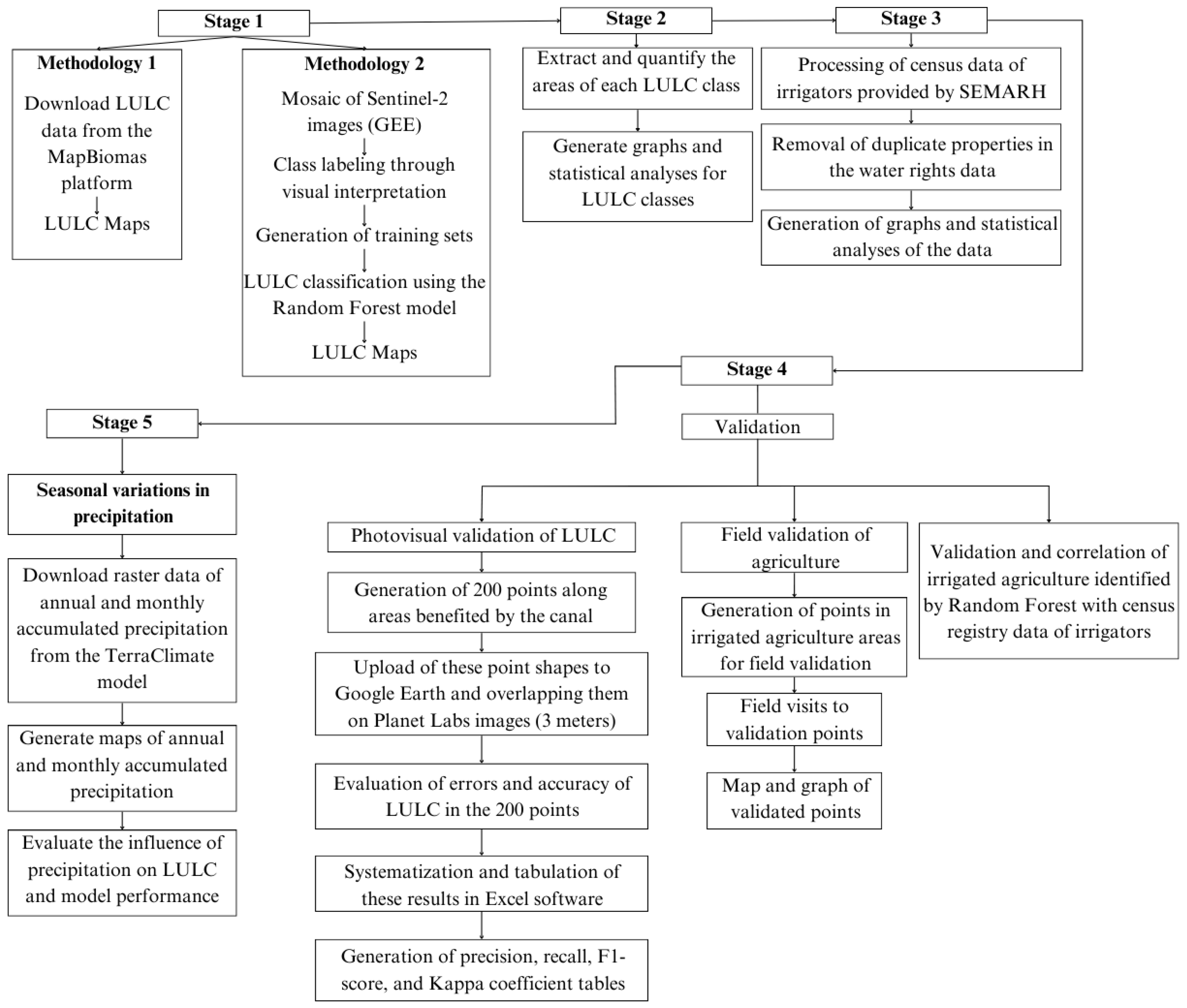
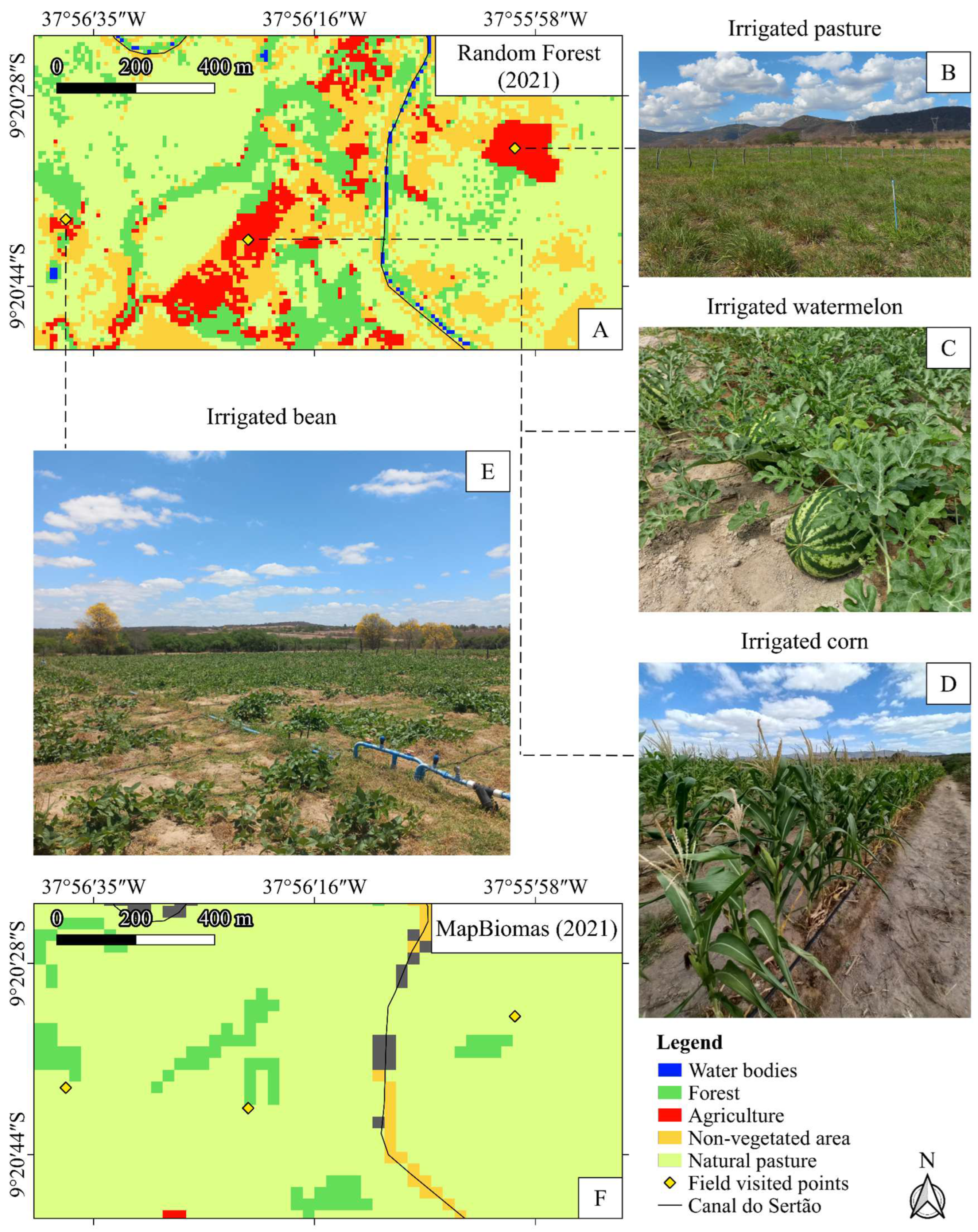
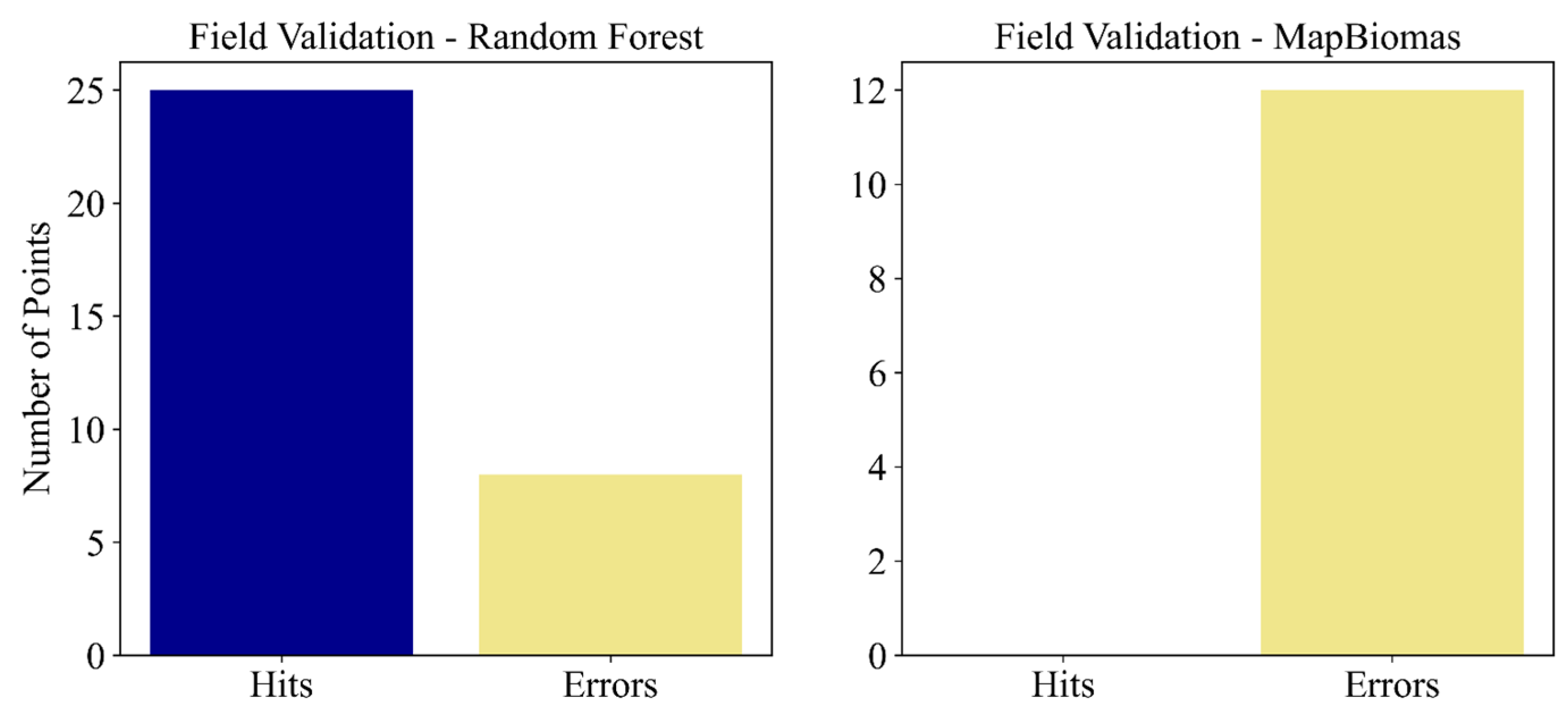


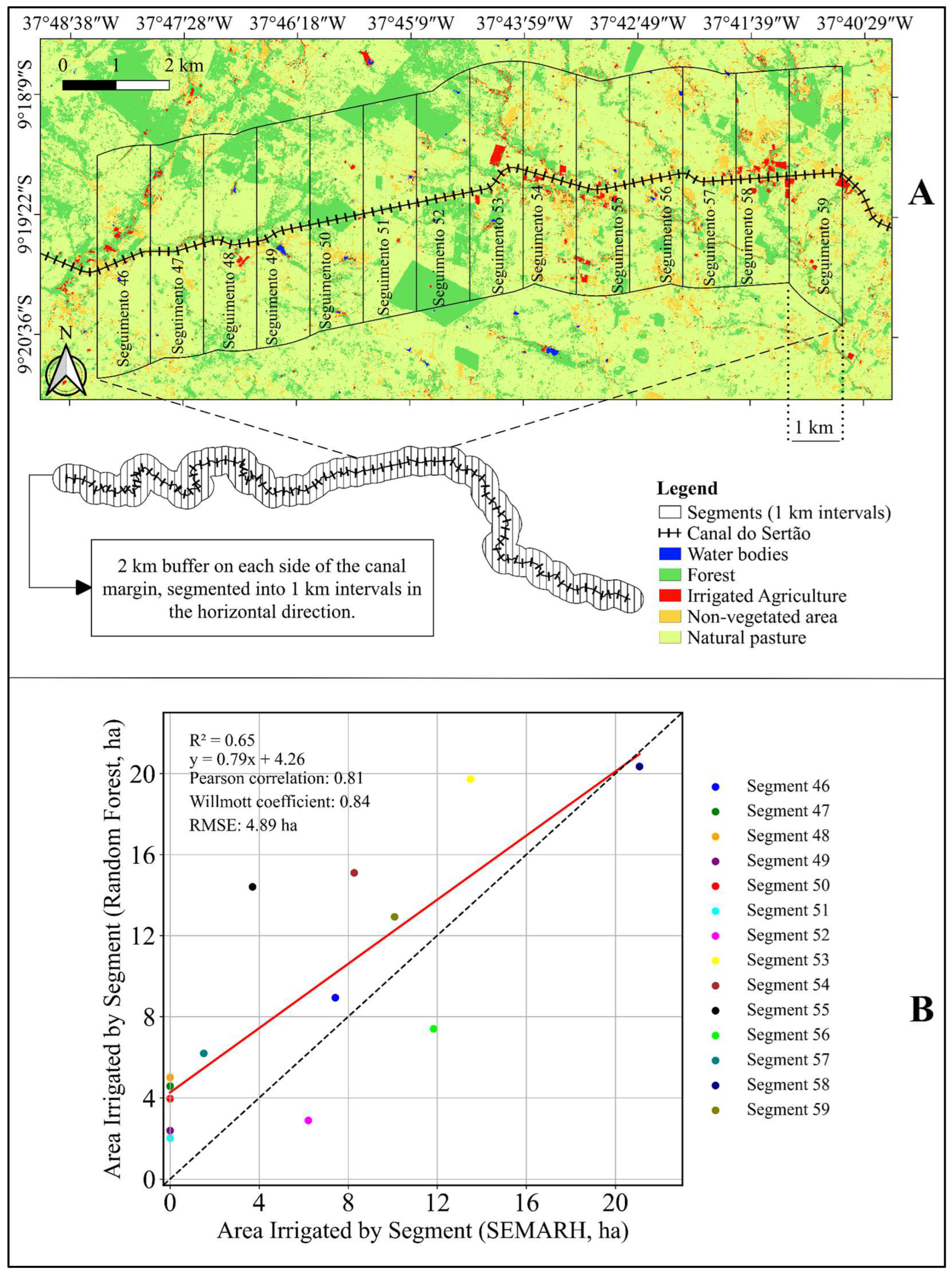
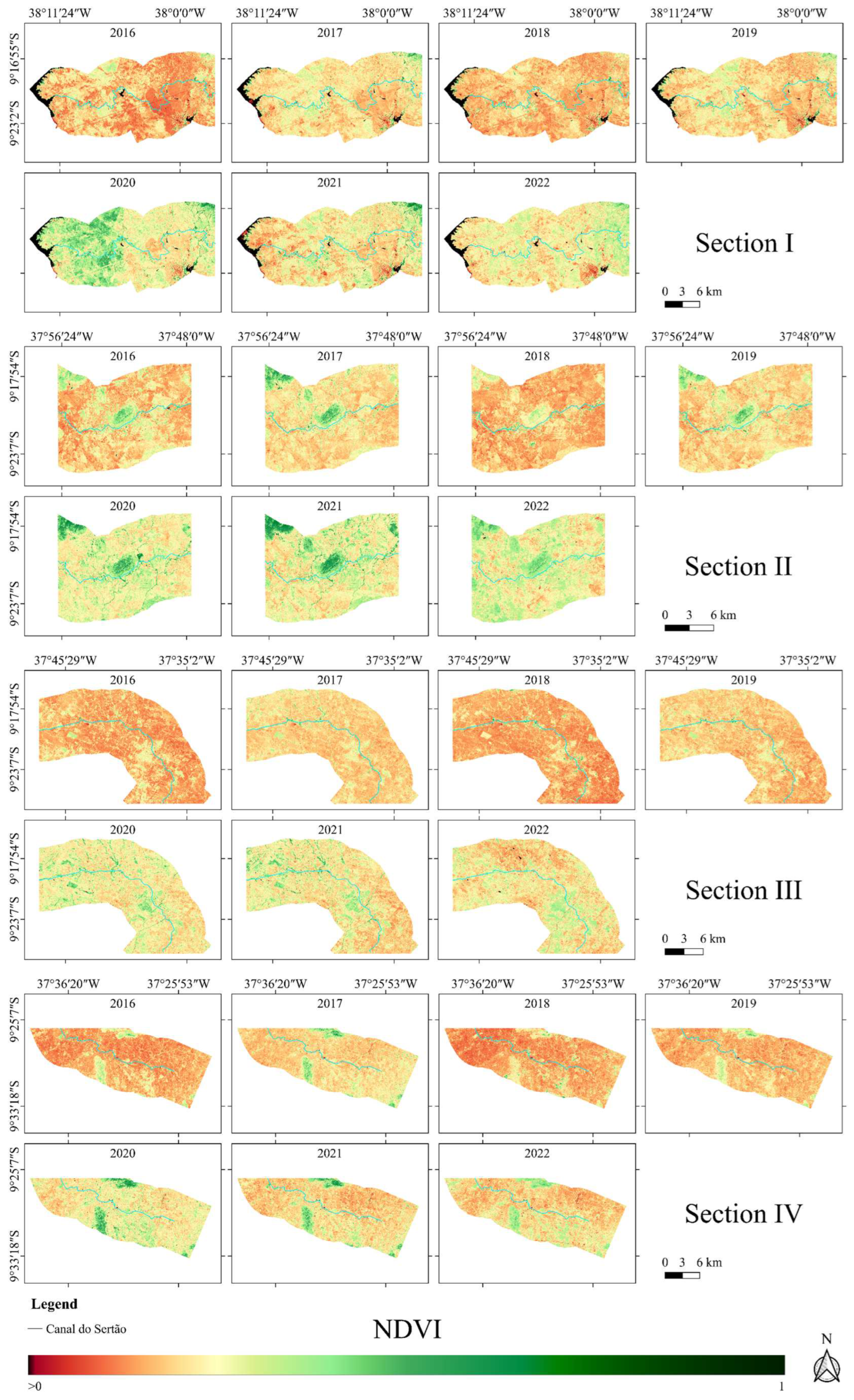
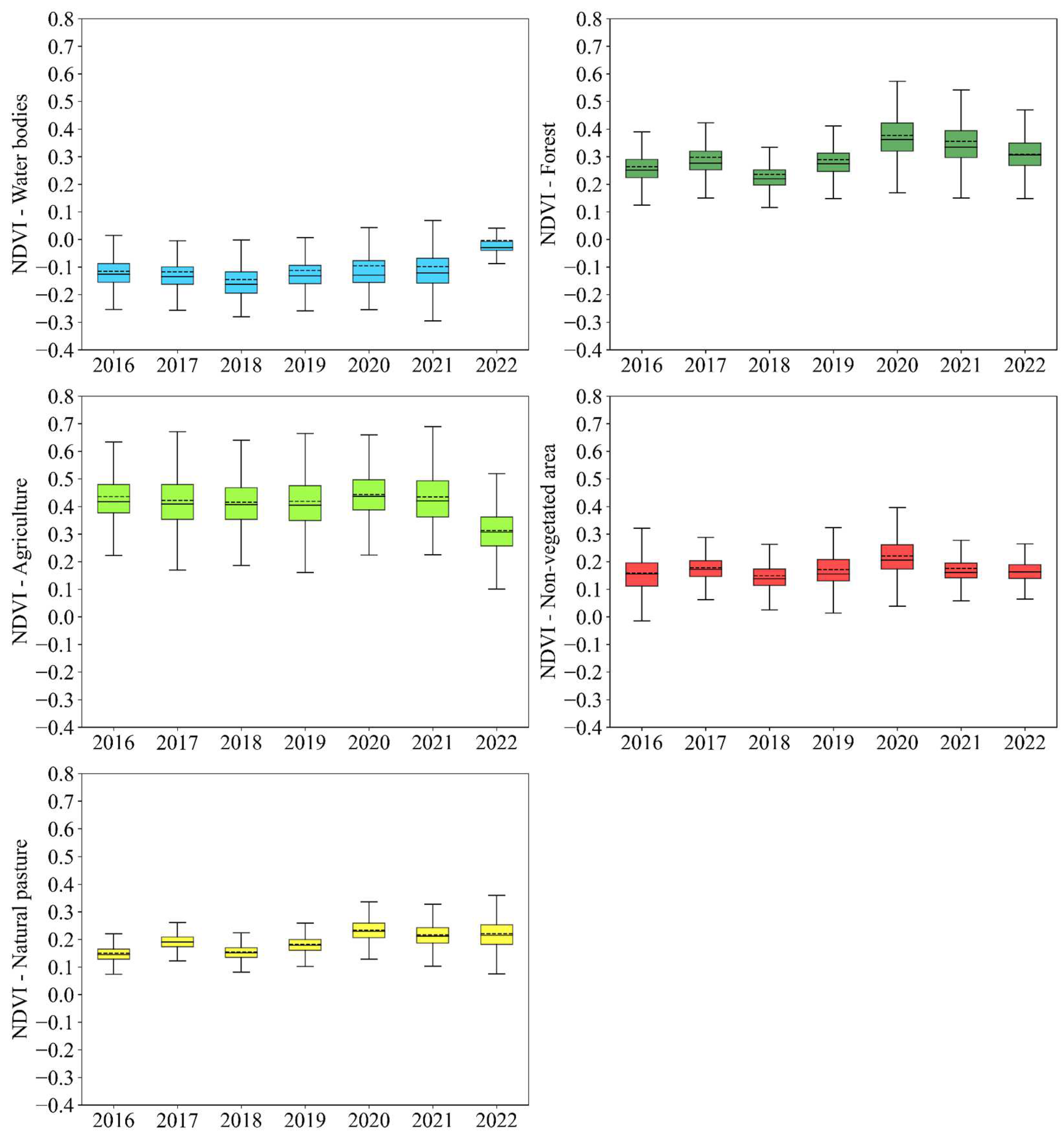
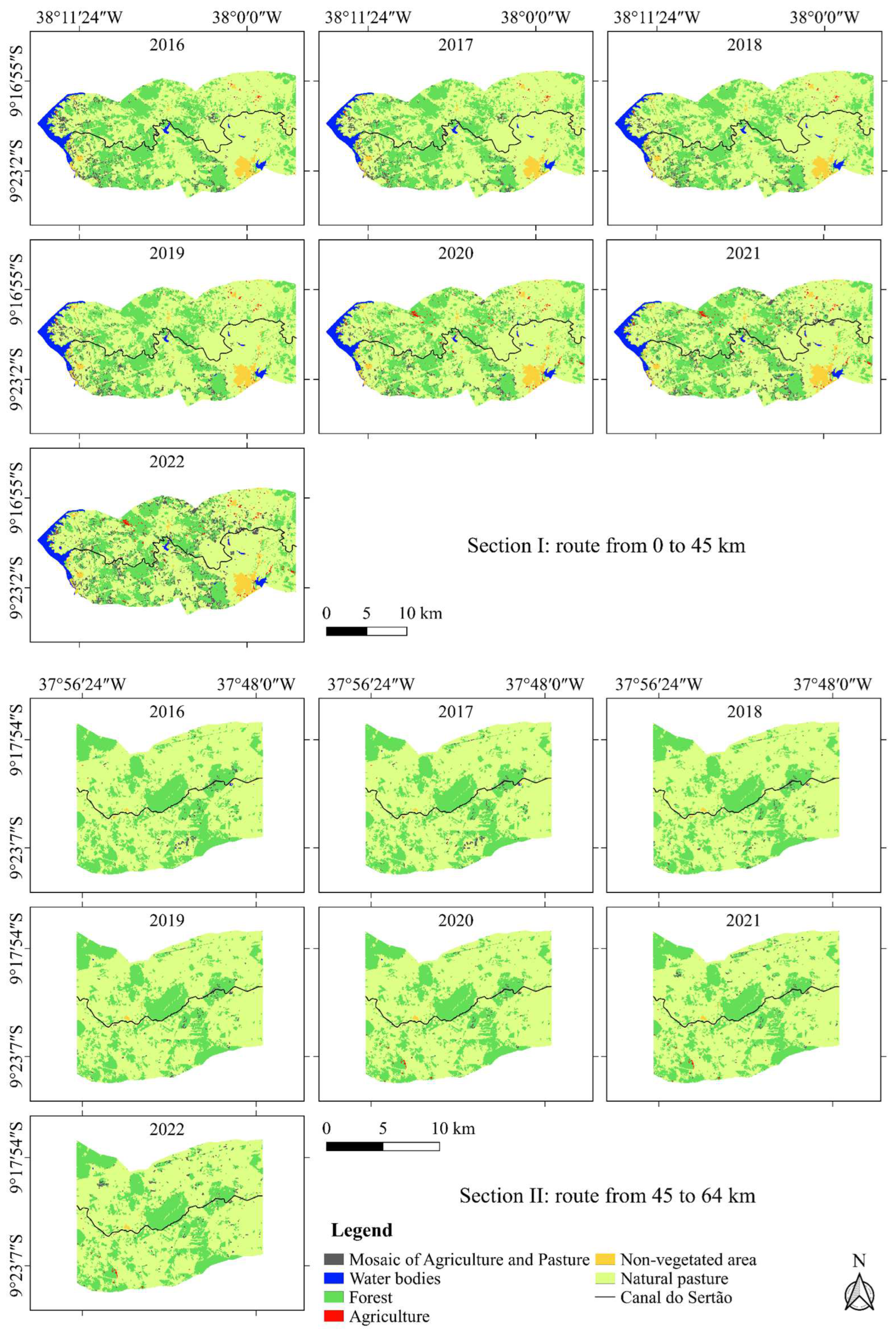

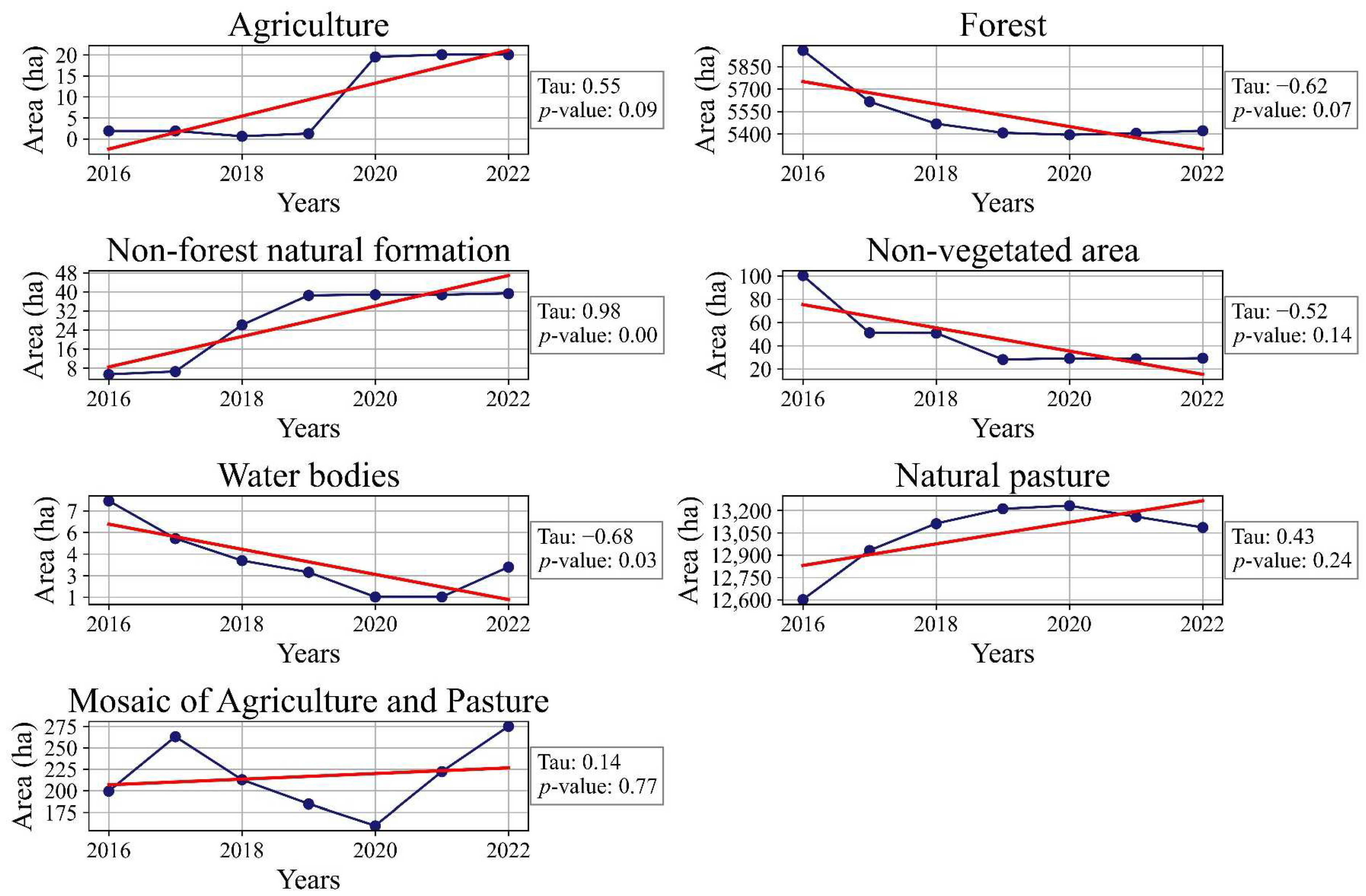
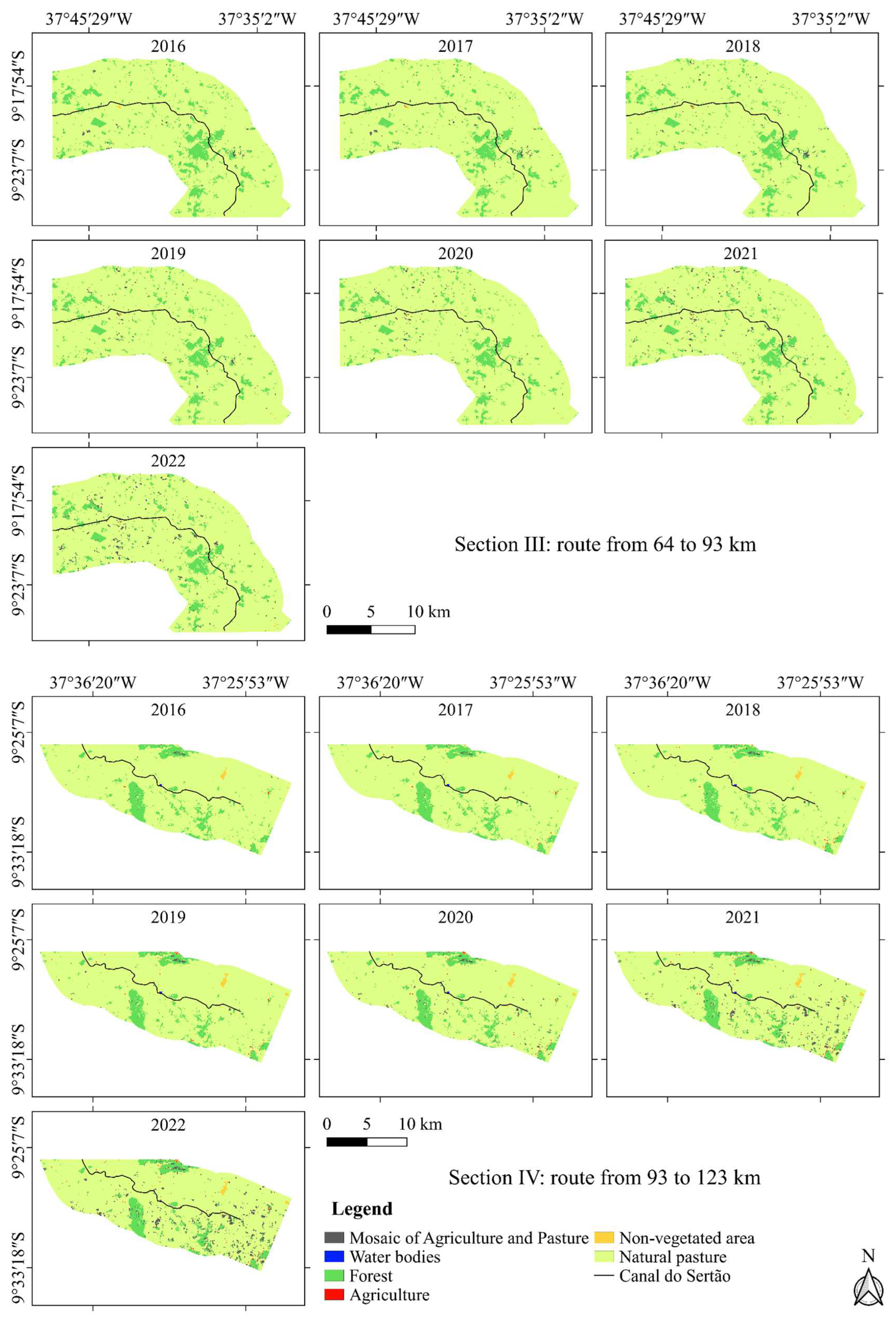
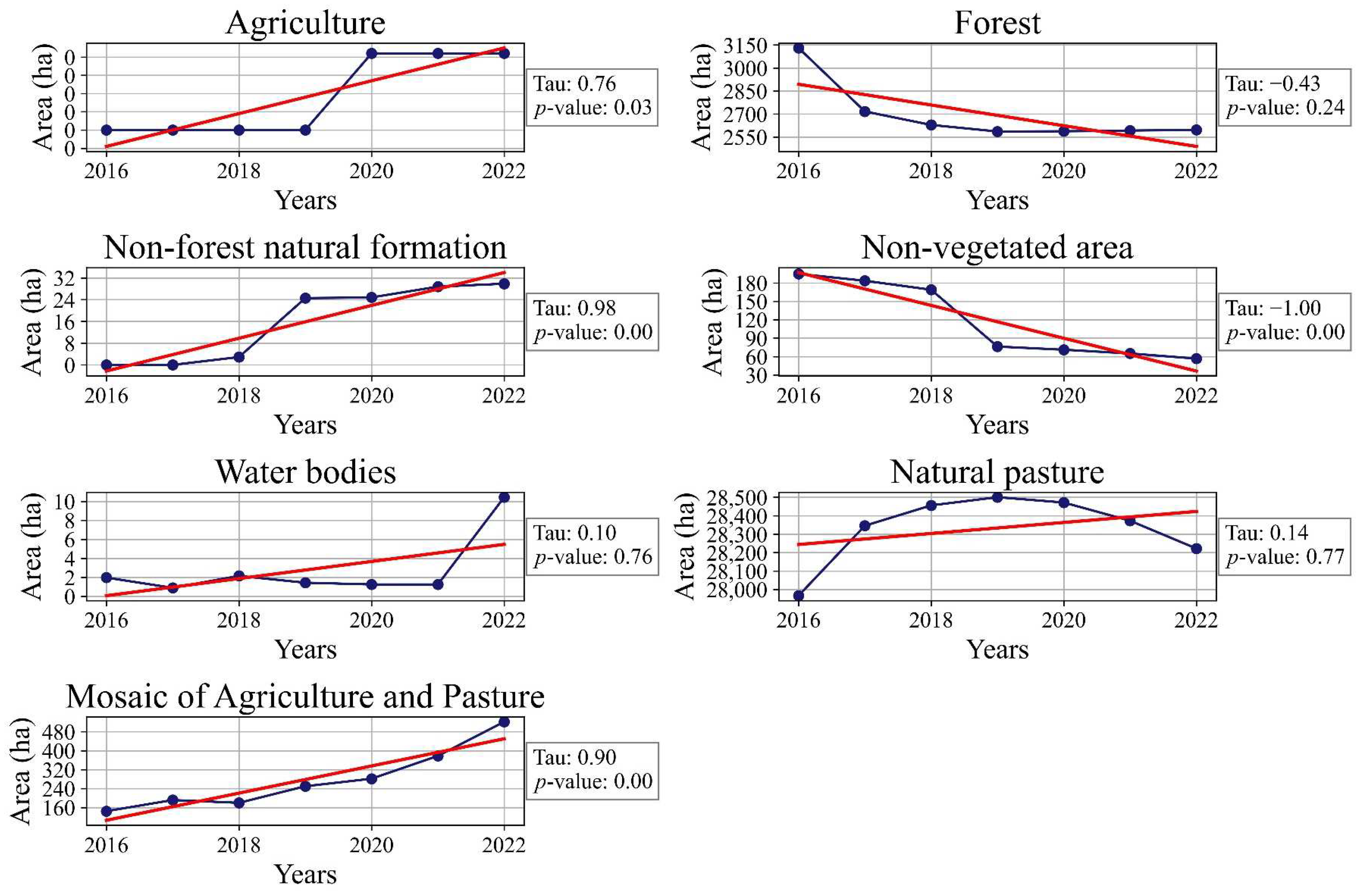
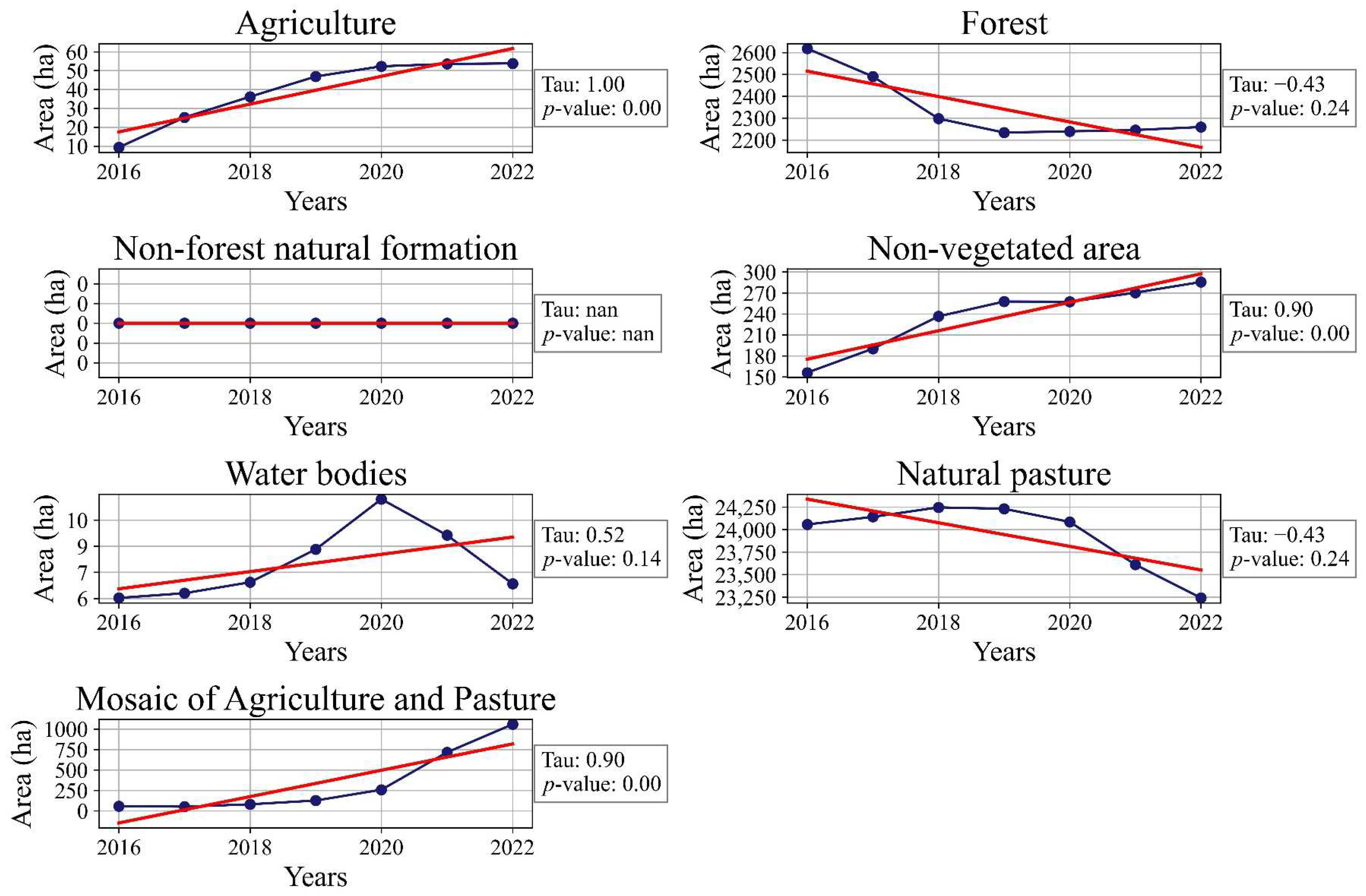
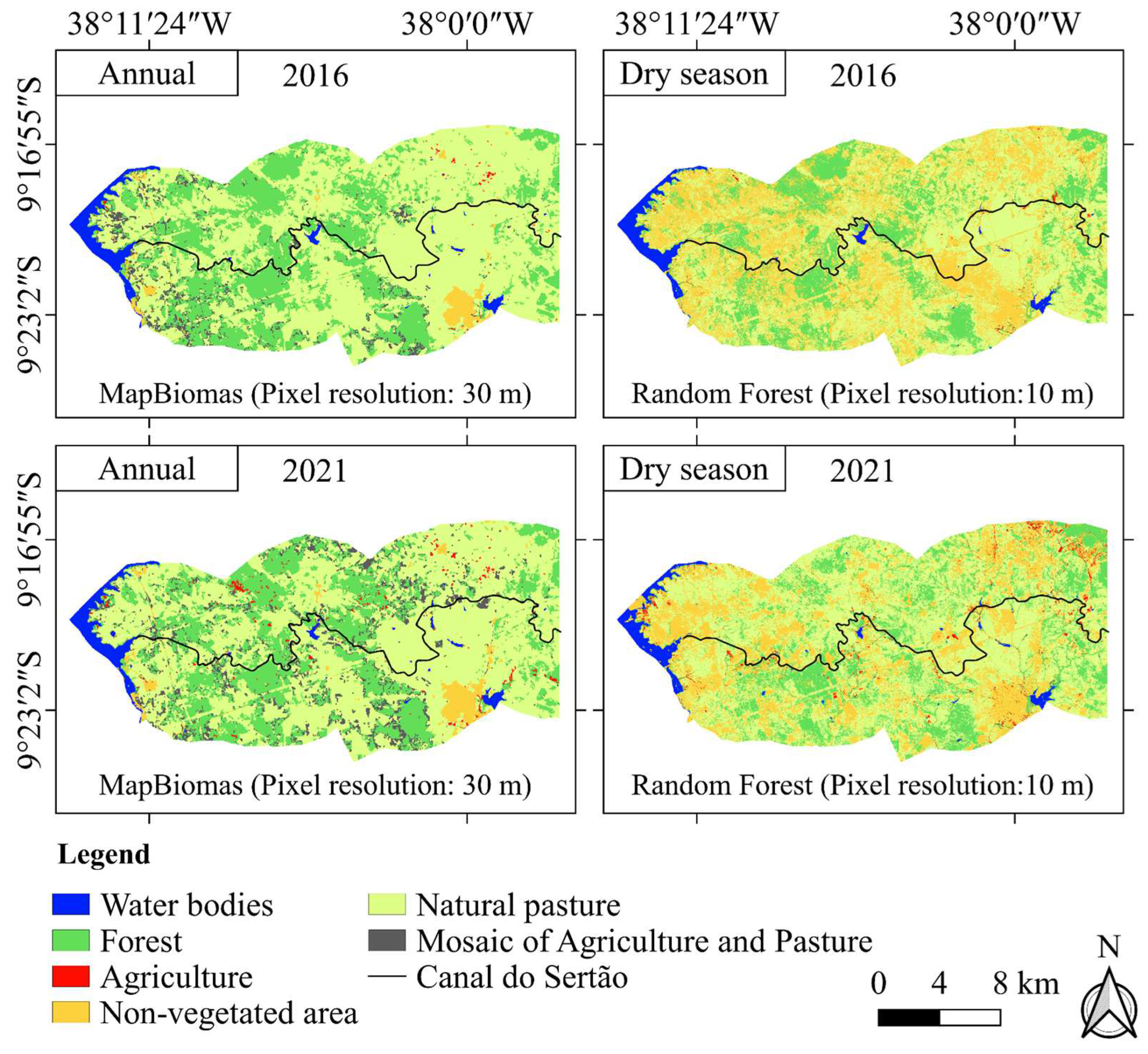
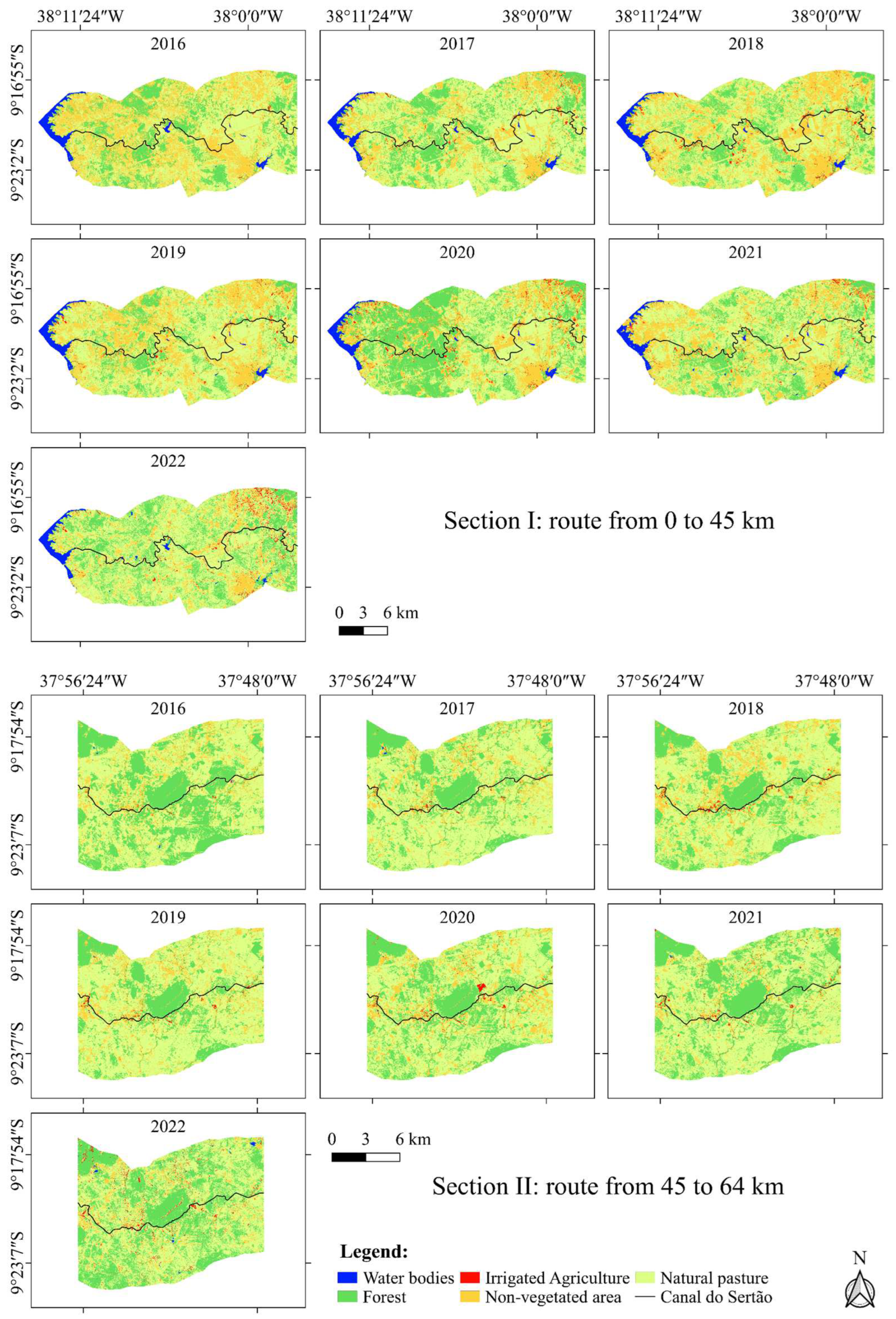
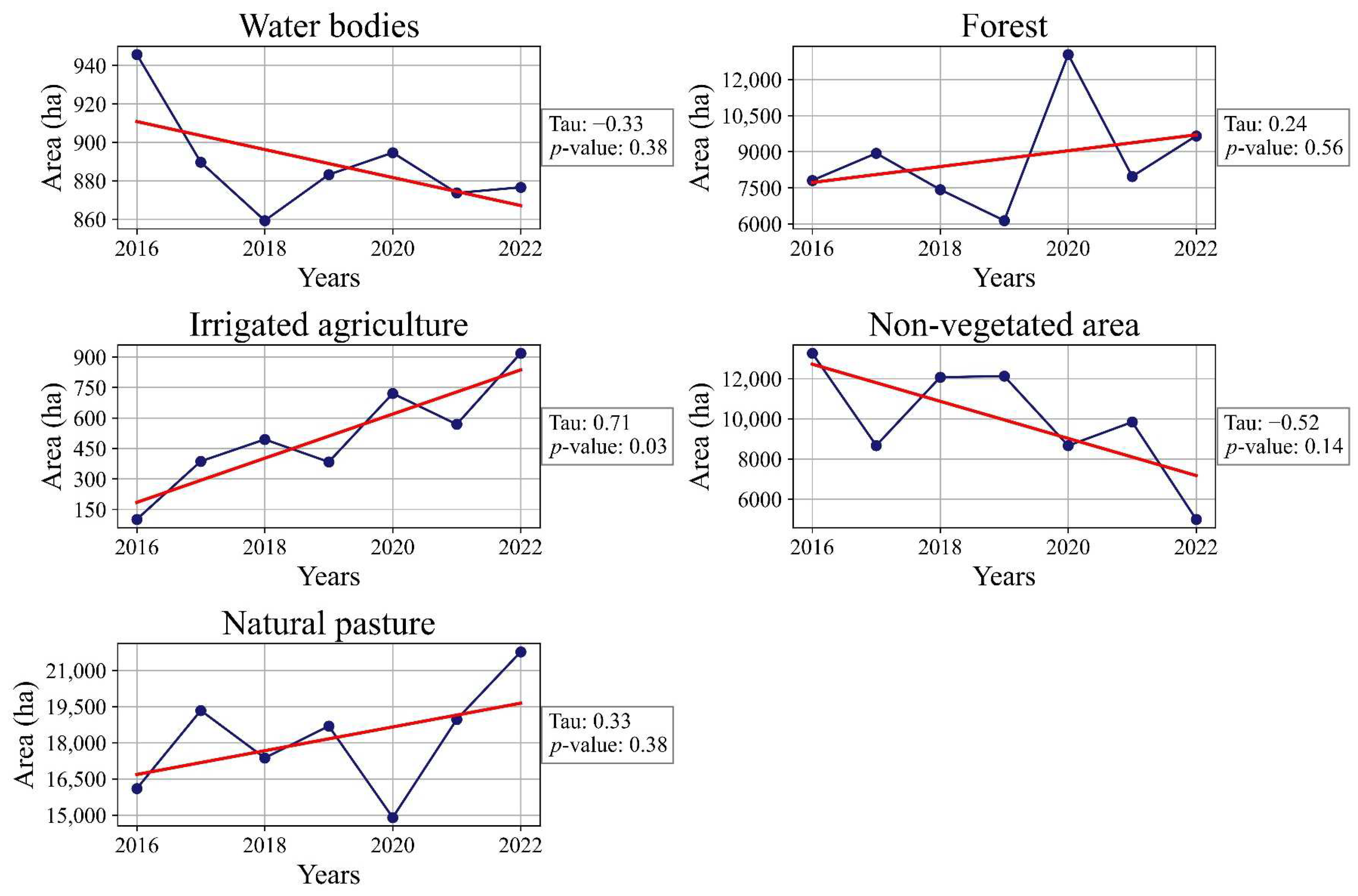
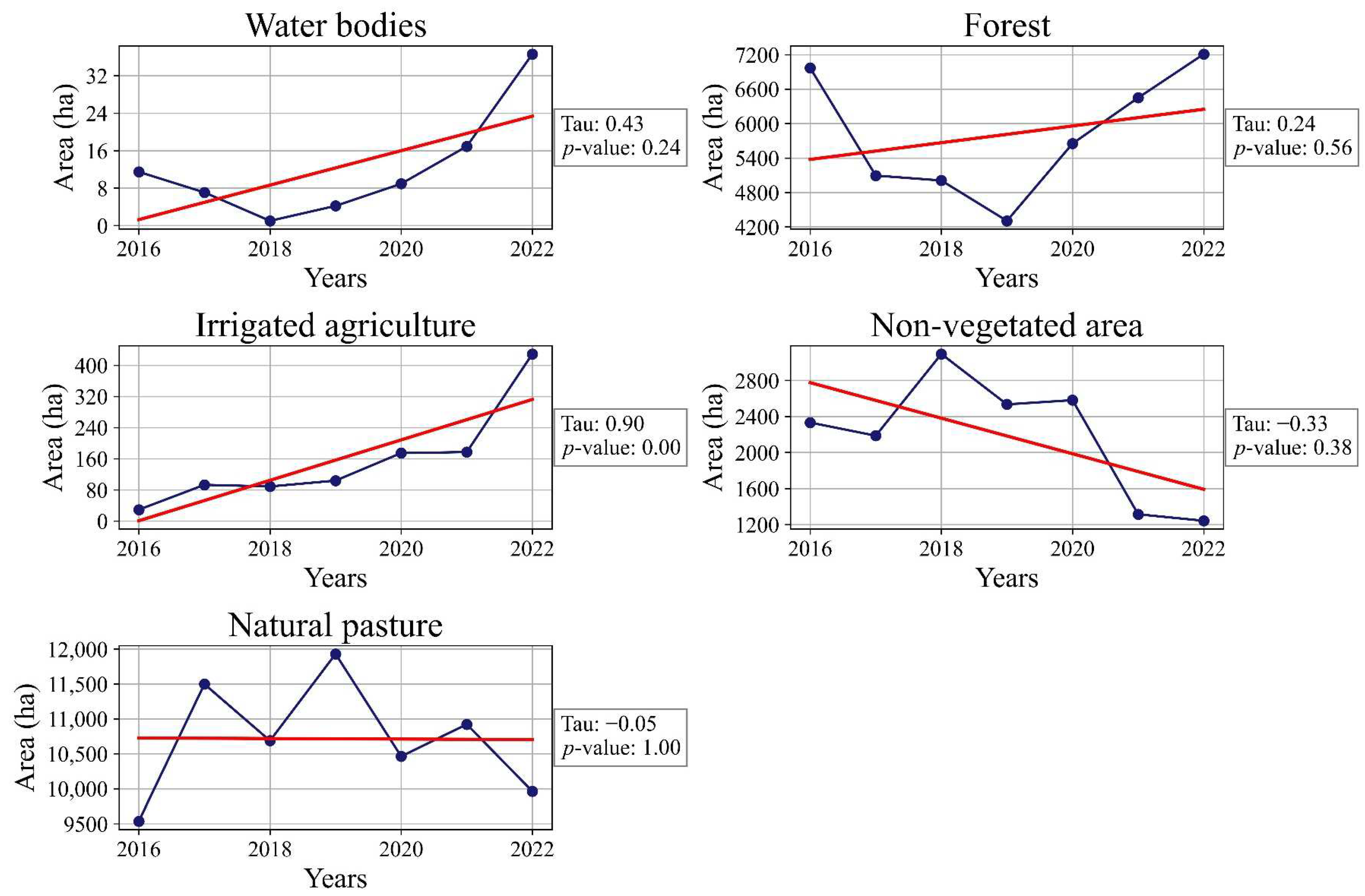
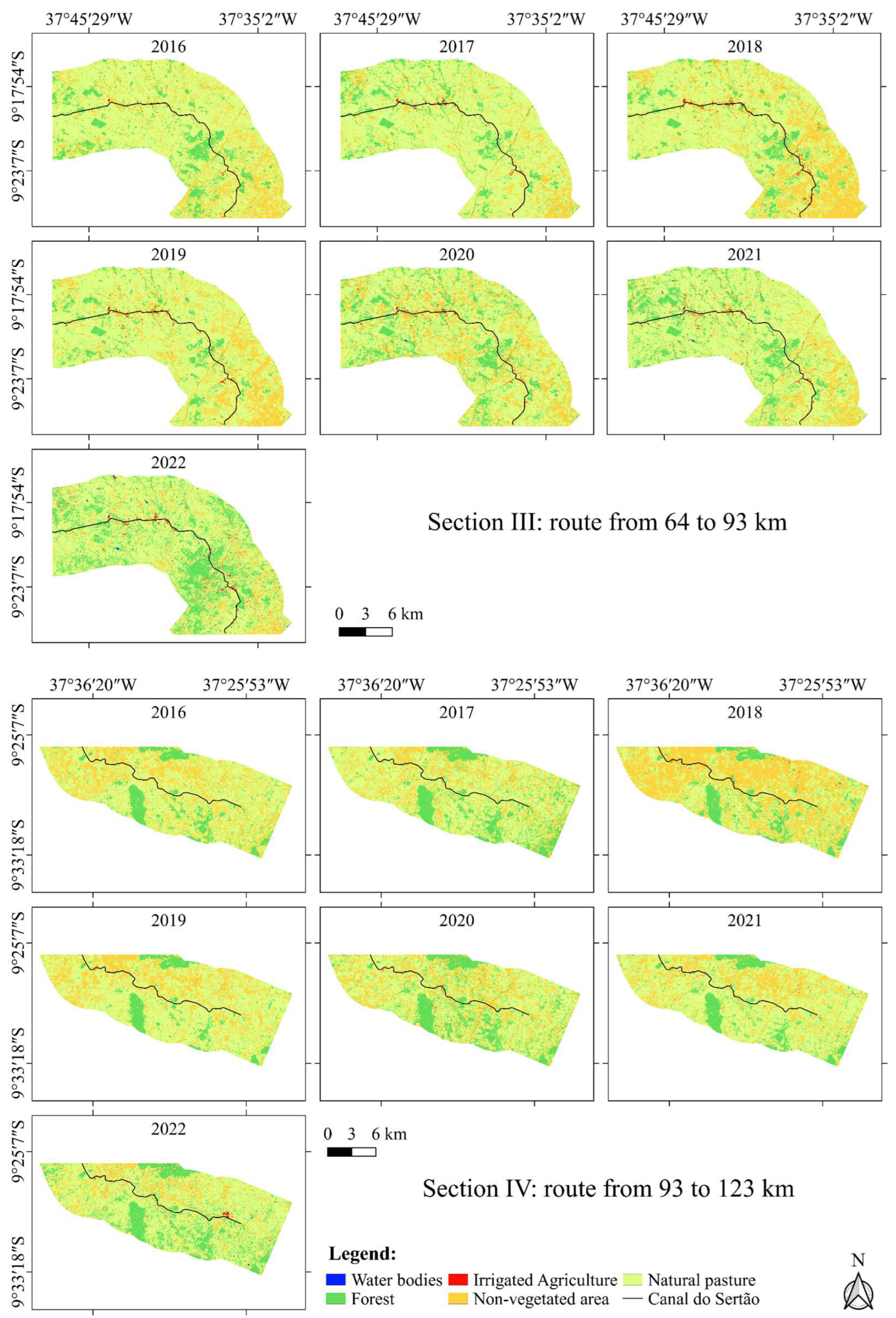
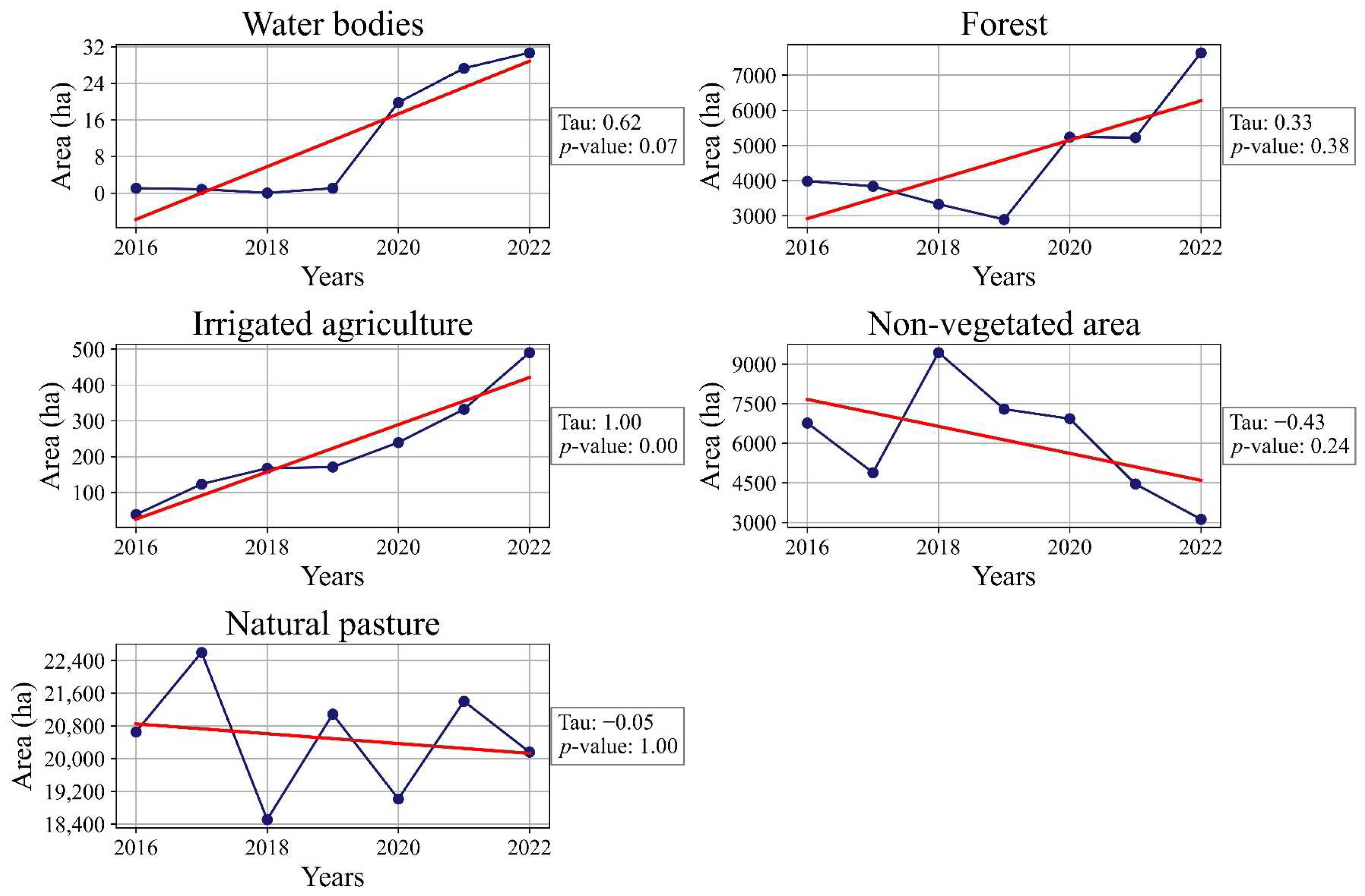
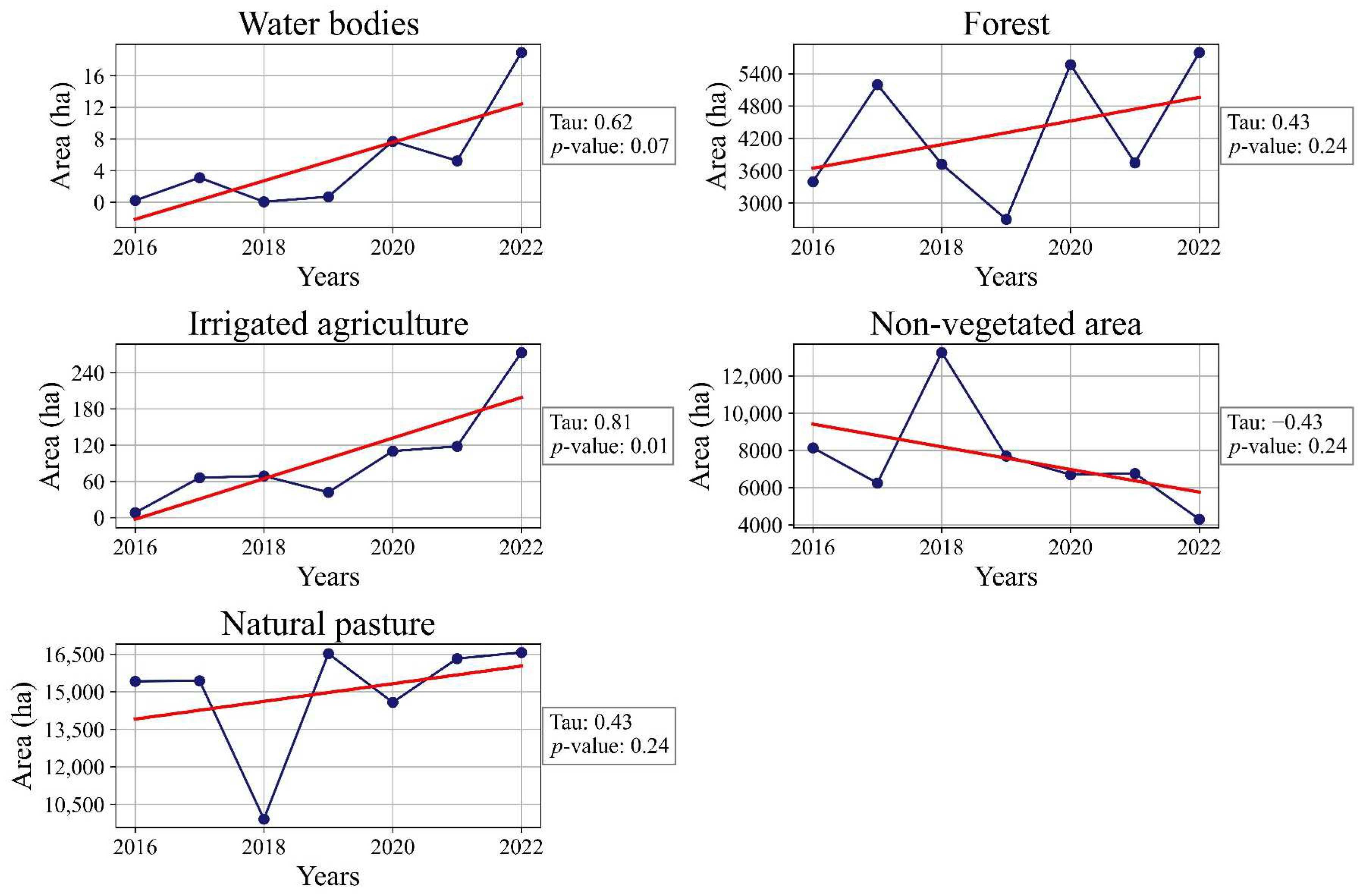

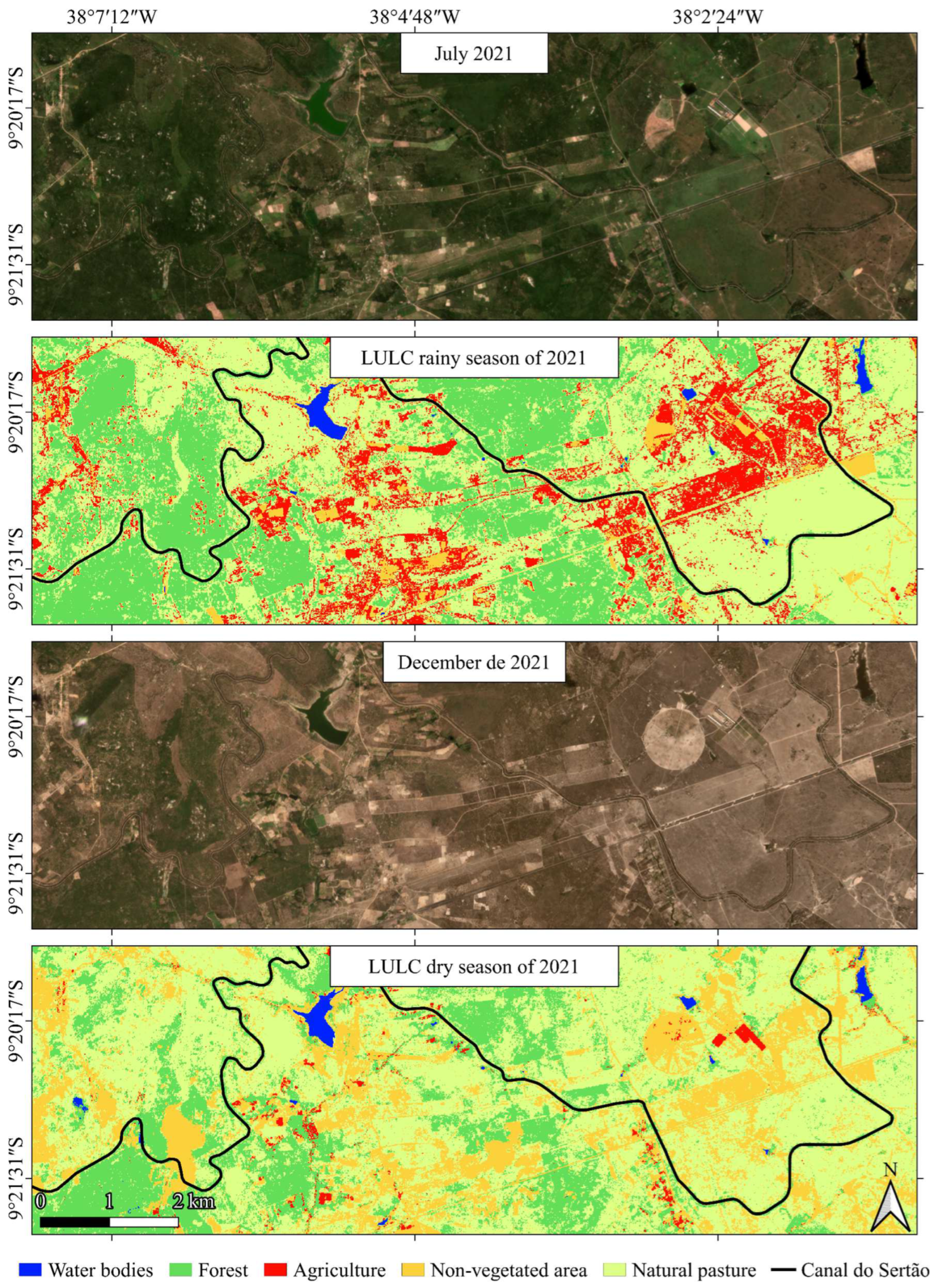
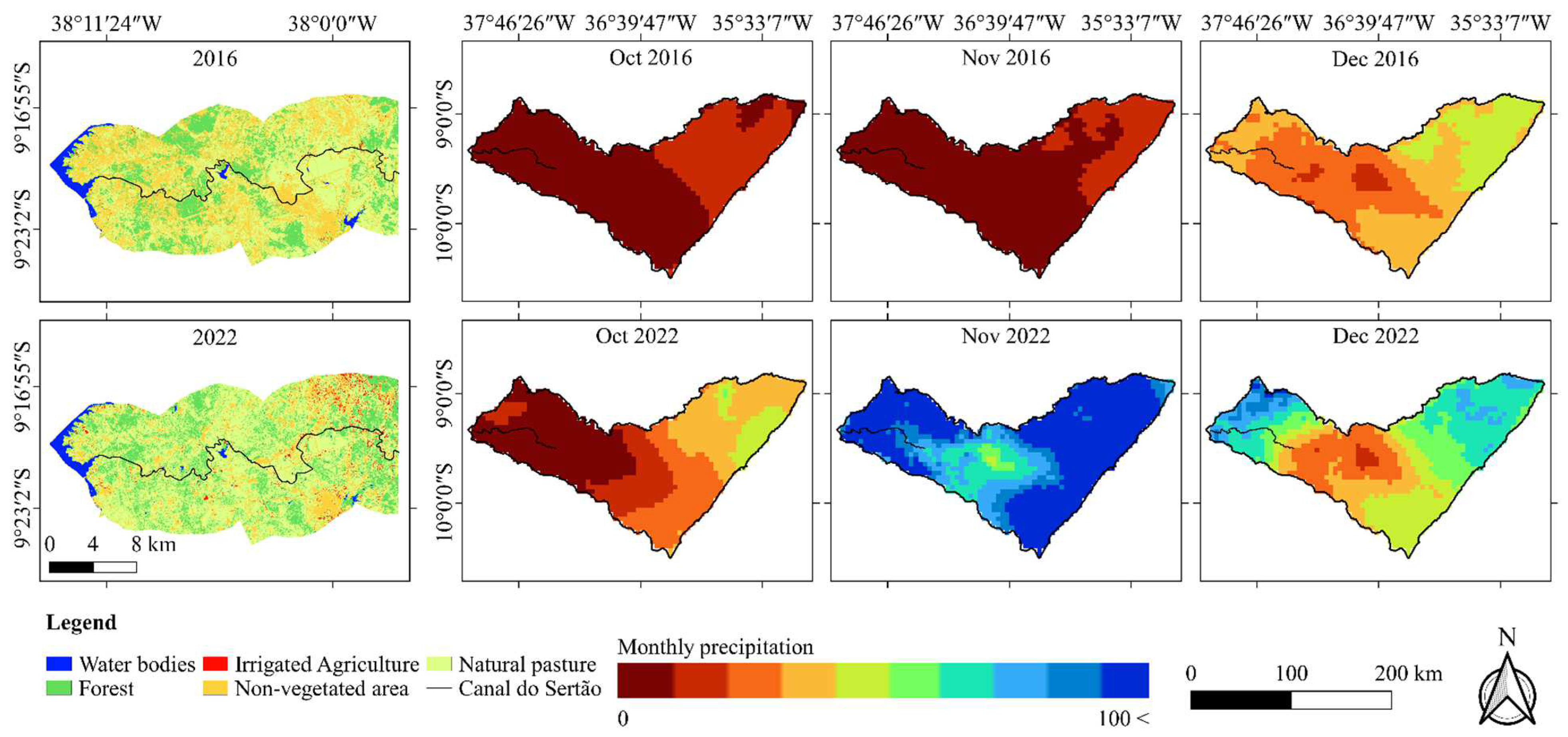
| Class | Year | ||||||
|---|---|---|---|---|---|---|---|
| 2016 | 2017 | 2018 | 2019 | 2020 | 2021 | 2022 | |
| Water bodies | 11 | 9 | 9 | 9 | 9 | 11 | 12 |
| Forest | 82 | 79 | 48 | 43 | 34 | 18 | 77 |
| Irrigated agriculture | 25 | 58 | 70 | 77 | 72 | 36 | 113 |
| Non-vegetated area | 15 | 13 | 16 | 10 | 7 | 13 | 45 |
| Natural pasture | 36 | 35 | 24 | 46 | 43 | 13 | 42 |
| Kappa | Class | Precision | Recall | F1 Score |
|---|---|---|---|---|
| 0.74 | Agriculture | 0.41 | 0.89 | 0.56 |
| Non-vegetated area | 1.00 | 0.88 | 0.94 | |
| Water bodies | 1.00 | 1.00 | 1.00 | |
| Forest | 1.00 | 0.53 | 0.69 | |
| Natural pasture | 0.90 | 0.96 | 0.93 |
| Kappa | Class | Precision | Recall | F1 Score |
|---|---|---|---|---|
| 0.82 | Irrigated agriculture | 0.65 | 1.00 | 0.79 |
| Non-vegetated area | 0.85 | 0.93 | 0.89 | |
| Water bodies | 1.00 | 0.92 | 0.96 | |
| Forest | 1.00 | 0.73 | 0.84 | |
| Natural pasture | 0.92 | 0.84 | 0.88 |
Disclaimer/Publisher’s Note: The statements, opinions and data contained in all publications are solely those of the individual author(s) and contributor(s) and not of MDPI and/or the editor(s). MDPI and/or the editor(s) disclaim responsibility for any injury to people or property resulting from any ideas, methods, instructions or products referred to in the content. |
© 2025 by the authors. Licensee MDPI, Basel, Switzerland. This article is an open access article distributed under the terms and conditions of the Creative Commons Attribution (CC BY) license (https://creativecommons.org/licenses/by/4.0/).
Share and Cite
Silva, J.L.P.d.; Júnior, G.d.N.A.; Silva Junior, F.B.d.; Silva, T.G.F.d.; Silva, J.B.A.d.; Scheibel, C.H.; Silva, M.V.d.; Mingoti, R.; Giongo, P.R.; Almeida, A.C.d.S. Performance of Land Use and Land Cover Classification Models in Assessing Agricultural Behavior in the Alagoas Semi-Arid Region. AgriEngineering 2025, 7, 134. https://doi.org/10.3390/agriengineering7050134
Silva JLPd, Júnior GdNA, Silva Junior FBd, Silva TGFd, Silva JBAd, Scheibel CH, Silva MVd, Mingoti R, Giongo PR, Almeida ACdS. Performance of Land Use and Land Cover Classification Models in Assessing Agricultural Behavior in the Alagoas Semi-Arid Region. AgriEngineering. 2025; 7(5):134. https://doi.org/10.3390/agriengineering7050134
Chicago/Turabian StyleSilva, José Lucas Pereira da, George do Nascimento Araújo Júnior, Francisco Bento da Silva Junior, Thieres George Freire da Silva, Jéssica Bruna Alves da Silva, Christopher Horvath Scheibel, Marcos Vinícius da Silva, Rafael Mingoti, Pedro Rogerio Giongo, and Alexsandro Claudio dos Santos Almeida. 2025. "Performance of Land Use and Land Cover Classification Models in Assessing Agricultural Behavior in the Alagoas Semi-Arid Region" AgriEngineering 7, no. 5: 134. https://doi.org/10.3390/agriengineering7050134
APA StyleSilva, J. L. P. d., Júnior, G. d. N. A., Silva Junior, F. B. d., Silva, T. G. F. d., Silva, J. B. A. d., Scheibel, C. H., Silva, M. V. d., Mingoti, R., Giongo, P. R., & Almeida, A. C. d. S. (2025). Performance of Land Use and Land Cover Classification Models in Assessing Agricultural Behavior in the Alagoas Semi-Arid Region. AgriEngineering, 7(5), 134. https://doi.org/10.3390/agriengineering7050134










